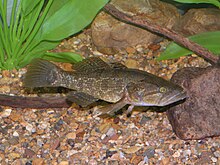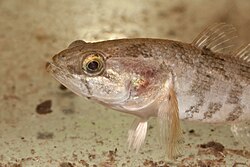| Chinese sleeper | |
|---|---|

| |
| Chinese sleeper in an aquarium | |
| Conservation status | |
 Least Concern (IUCN 3.1) | |
| Scientific classification | |
| Domain: | Eukaryota |
| Kingdom: | Animalia |
| Phylum: | Chordata |
| Class: | Actinopterygii |
| Order: | Gobiiformes |
| Family: | Odontobutidae |
| Genus: | Perccottus Dybowski, 1877 |
| Species: | P. glenii |
| Binomial name | |
| Perccottus glenii Dybowski, 1877 | |

| |
| The range of the Chinese sleeper (native in green; introduced in red) | |
| Synonyms | |
| |
The Chinese sleeper (Perccottus glenii), also known as the Amur sleeper, is a species of freshwater sleeper native to the Amur River basin in eastern Asia with introduced populations in other regions of Eurasia. It is currently the only known member of its genus.
Description


The Chinese sleeper, known as rotan in Russia, resembles a perch, ruffe, or sculpin. The eyes are placed high on the head, which has a rounded snout and projecting lower jaw. There is little or no gap between the two dorsal fins, the front one of which has six to eight spines and the back one, nine to eleven soft rays. The anal fin has one to three spines and seven to ten soft rays. The pelvic fins are not fused together, which helps to distinguish this fish from the gobies. The second dorsal and the anal fins are both more rounded and shorter than the gobies and the caudal fin is also more rounded. The general colour is brownish with a checker-board pattern of darker marks or dark barring. There are dark lines on the head radiating from the eye. This species can reach a length of 25 centimetres (9.8 in) TL and the greatest recorded weight for a specimen is 250 grams (8.8 oz).
Distribution and habitat
The Chinese sleeper is native to the inland waters of north-eastern China, northern North Korea, and the Russian Far East. Specimens were first transported to Saint Petersburg from the River Zeya in 1912 by a scientific expedition as ornamental fish. During the 1920s, the Chinese sleeper invaded many water bodies around Saint Petersburg and in the 1950s, it was recorded in the shallow waters of the Gulf of Finland in the Baltic Sea and was considered an invasive species. Its typical habitat is ponds, closed water-bodies, and slow-moving streams. The westernmost locality of the Chinese sleeper range is the ponds in the Bavarian Danube basin in Germany. A finding in the mesohaline environment is registered in the North-Western Black Sea in Ukraine.
Invasiveness
In Europe, the Chinese sleeper has been included in the list of Invasive Alien Species of Union concern (the Union list) since 2016. This implies that this species cannot be imported, bred, transported, commercialized, or intentionally released into the environment in the whole of the European Union. At least one case of monospecific fish community composed of Chinese sleeper is registered in Latvia. In the late summer of 2022, a small community of Chinese sleepers was found in a single pond in southwest Finland, the first record of the species in the country. This fish has been reported from Czechia recently
Behaviour
The Chinese sleeper is an adaptable species and is tolerant of widely different conditions. It feeds on insects and their larvae, small crustaceans, and fish fry. It spawns in warm shallows among vegetation and the male guards the eggs.
Economic importance
This species is of minor importance to local commercial fisheries and has the potential as an aquarium fish. However, introduced populations are of concerns as they could become detrimental to the local fauna due to their predatory nature and voracious appetite.
References
- Bogutskaya, N. (2022). "Perccottus glenii". IUCN Red List of Threatened Species. 2022: e.T159715238A159715260. doi:10.2305/IUCN.UK.2022-1.RLTS.T159715238A159715260.en. Retrieved 1 February 2024.
- ^ Froese, Rainer; Pauly, Daniel (eds.). "Perccottus glenii". FishBase. February 2014 version.
- ^ "Chinese sleeper". NatureGate. Retrieved 2013-12-26.
- ^ Grabowska, Joanna; Kvach, Yuriy; Rewicz, Tomasz; Pupins, Mihails; Kutsokon, Iuliia; Dykyy, Ihor; Antal, Laszlo; Zięba, Grzegorz; Rakauskas, Vytautas; Trichkova, Teodora; Čeirāns, Andris; Grabowski, Michał (1 June 2020). "First insights into the molecular population structure and origins of the invasive Chinese sleeper, Perccottus glenii, in Europe". NeoBiota. 57: 87–107. doi:10.3897/neobiota.57.48958. hdl:2437/290535. S2CID 222122684. Retrieved 3 February 2023.
- ^ Lukina, I. I. (2011). "Distribution of the Amur sleeper (Perccottus glenii Dybowski, 1877) in Belarus". Russian Journal of Biological Invasions. 2 (2–3): 209–212. Bibcode:2011RuJBI...2..209L. doi:10.1134/S2075111711030088. S2CID 25966291.
- Reshetnikov, A. N.; Schliewen, U. K. (2013). "First record of the invasive alien fish rotan Perccottus glenii Dybowski, 1877 (Odontobutidae) in the Upper Danube drainage (Bavaria, Germany)". Journal of Applied Ichthyology. 29 (6): 1367–1369. Bibcode:2013JApIc..29.1367R. doi:10.1111/jai.12256.
- Nehring S., Steinhof J. (2015). "First records of the invasive Amur sleeper, Perccottus glenii Dybowski, 1877 in German freshwaters: a need for realization of effective management measures to stop the invasion". BioInvasions Records. 4 (3): 223–232. doi:10.3391/bir.2015.4.3.12.
- Kvach Y., Karavanskyi Y., Tkachenko P., Zamorov V. (2021). "First record of the invasive Chinese sleeper, Perccottus glenii Dybowski, 1877 (Gobiiformes: Odontobutidae) in the Black Sea". BioInvasions Records. 10 (2): 411–418. doi:10.3391/bir.2021.10.2.19.
{{cite journal}}: CS1 maint: multiple names: authors list (link) - "List of Invasive Alien Species of Union concern - Environment - European Commission". ec.europa.eu. Retrieved 2021-07-27.
- "REGULATION (EU) No 1143/2014 of the European parliament and of the council of 22 October 2014 on the prevention and management of the introduction and spread of invasive alien species". Archived from the original on 2017-03-03.
- Kutsokon I., Tkachenko M., Bondarenko O., Pupins M., Snigirova A., Berezovska V., Čeirāns A., Kvach Y. (2021). "The role of invasive Chinese sleeper Perccottus glenii Dybowski, 1877 in the Ilgas Nature Reserve ecosystem: an example of a monospecific fish community". BioInvasions Records. 10 (2): 396–410. doi:10.3391/bir.2021.10.2.18.
{{cite journal}}: CS1 maint: multiple names: authors list (link) - Kuningas, Sanna (2022-09-26). "First findings of the Chinese sleeper in Finland – spreading invasive alien species is illegal". Natural Resources Institute Finland. Retrieved 2022-11-10.
- Šmejkal, Marek; Dočkal, Ondřej; Thomas, Kiran; Kalous, Lukáš (2023). "First record of highly invasive Chinese sleeper Perccottus glenii Dybowski, 1877 (Perciformes: Odontobutidae) in the Elbe River Basin, Czechia". Aquatic Ecology. 58: 125–130. bioRxiv 10.1101/2023.01.20.524995. doi:10.1007/s10452-023-10036-8. S2CID 256195361.